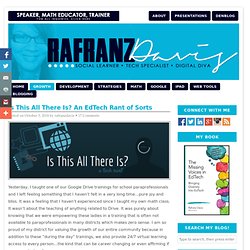

Your Rubric Is a Hot Mess; Here’s How to Fix It. Share with Friends 28.1KShares See Mrs.

Jones. She has a fantastic idea for a new assignment. It’s going to be challenging and engaging and fun. Then it’s time to build a rubric. See Mrs. If you’re like Mrs. Then, when it comes time to assess student work, you’re likely to find many assignments that don’t fit neatly into any one column.
And do students even read these rubrics? Might there be a better way? Instead of detailing all the different ways an assignment deviates from the target, the single-point rubric simply describes the target, using a single column of traits. For some, this alternative might cause apprehension: does this mean more writing for the teacher? With a single-point rubric, the farce of searching for the right pre-scripted language is over, leaving you free to describe exactly what this student needs to work on.
Is there ever a need for a fully loaded, “hot mess” rubric? But a teacher aspires to more than that. You and me and Mrs. About The Author Jennifer Gonzalez. The Four Stages Of The Self-Directed Learning Model. Four Stages Of A Self-Directed Learning Model by TeachThought Staff Self-Directed Learning is not new, but is perhaps misunderstood.

Studied in terms of adult education and vocation for years, self-directed learning is increasing in popularity for a variety of reasons, including growing dissatisfaction with public schooling, and the rich formal and informal learning materials available online. This is the “age of information” after all. Self-directed learning is one response, something slideshare user Barbara Stokes captures in this chart, based on the model by Gerald Grow. The four stages–very similar to the gradual release of responsibility model–appear below.
The Four Stages Of The Self-Directed Learning Model Learner Teacher Stage 1 Dependent Authority, Coach Stage 2: Interested Motivator, Guide Stage 3: Involved Facilitator Stage 4: Self-Directed Consultant, Delegator. PZ Thinking Routines. Audri's Rube Goldberg Monster Trap. Is This All There Is? An EdTech Rant of Sorts. Yesterday, I taught one of our Google Drive trainings for school paraprofessionals and I left feeling something that I haven’t felt in a very long time…pure joy and bliss.

It was a feeling that I haven’t experienced since I taught my own math class. It wasn’t about the teaching of anything related to Drive. It was purely about knowing that we were empowering these ladies in a training that is often not available to paraprofessionals in many districts which makes zero sense. I am so proud of my district for valuing the growth of our entire community because in addition to these “during the day” trainings, we also provide 24/7 virtual learning access to every person…the kind that can be career changing or even affirming if a person desires it.
Every district should do this…every…single…one. Later that evening, amidst crazy school canceling storms, I found myself looking through conference proposals and sessions. How are we encouraging creativity and innovation? Metacognition: The Gift That Keeps Giving. Editor's note: This post is co-authored by Marcus Conyers who, with Donna Wilson, is co-developer of the M.S. and Ed.S.

Brain-Based Teaching degree programs at Nova Southeastern University. They have written several books, including Five Big Ideas for Effective Teaching: Connecting Mind, Brain, and Education Research to Classroom Practice. Students who succeed academically often rely on being able to think effectively and independently in order to take charge of their learning. These students have mastered fundamental but crucial skills such as keeping their workspace organized, completing tasks on schedule, making a plan for learning, monitoring their learning path, and recognizing when it might be useful to change course.
They do not need to rely on their teacher as much as others who depend on more guidance to initiate learning tasks and monitor their progress. Metacognition in the Brain How to Teach Students to Be More Metacognitive Reference.